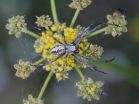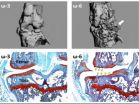(Press-News.org) Using spider toxins to study the proteins that let nerve cells send out electrical signals, Johns Hopkins researchers say they have stumbled upon a biological tactic that may offer a new way to protect crops from insect plagues in a safe and environmentally responsible way.
Their finding—that naturally occurring insect toxins can be lethal for one species and harmless for a closely related one—suggests that insecticides can be designed to target specific pests without harming beneficial species like bees. A summary of the research, led by Frank Bosmans, Ph.D., an assistant professor of physiology at the Johns Hopkins University School of Medicine, will be published July 11 in the journal Nature Communications.
"Most insecticides used today take a carpet-bombing approach, killing indiscriminately and sometimes even hurting humans and other animals," says Bosmans. "The more specific a toxin's target, the less dangerous it is for everything else."
Their finding began with the mistaken inclusion of a protein, called Dc1a, in a shipment sent by the team's Australian collaborators. The protein was extracted from the venom of the desert bush spider Diguetia canities, which lives in the deserts of the southwestern United States and Mexico and is harmless to humans.
When Bosmans' Australian collaborators tested the impact of Dc1a on proteins from American cockroaches, the proteins reacted very weakly, so they hadn't planned on sending Dc1a to Bosmans for further study. But it was accidentally included with other spider venom proteins for Bosmans' group to test, says Bosmans, so his laboratory did so.
The Bosmans lab studies proteins called sodium channels, which are found in the outer envelope of nerve cells throughout the body. Stimuli, like the acute pressure of hitting your finger with a hammer, are communicated to the proteins, causing them to open their pores so that sodium flows in. The positive charge of sodium causes an electrical signal to be sent down the nerve, eventually reaching the spinal cord and brain so the body can react.
"Sodium channels are the fastest ion channels in the human body and are needed to experience nearly every sensation, so mutations in them can lead to severe disorders of the nerves, muscles and heart," Bosmans says. That makes them a critical target for scientific study.
To understand the channels better, Bosmans and his team insert the protein's gene into frog eggs, which are large and easy to study. They can then use electrodes to monitor the flow of sodium into the cells. Adding spider toxins that interfere with the function of the channels sheds light on the channels' activity, since different toxins inhibit different parts of the protein, causing different effects. In addition to testing human sodium channels, the team sometimes works with sodium channels from insects.
Because his laboratory recently acquired the gene for the German cockroach sodium channel, Bosmans' team tested Dc1a on the protein and saw a startling increase in the channels' activity. "Sodium poured into the cells. In a bug, that would cause massive seizures, much like being electrocuted," says Bosmans. "Luckily, the toxin doesn't act on human sodium channels."
Curious about the difference between the two cockroach species' channels, they first identified the region of the channel that the toxin targets, but it turned out to be exactly the same in the two bugs. Digging deeper, they found a region nearby that differed by just two amino acids, the basic building blocks of the proteins. When mutations were made in the German version so that its amino acids were the same as the American version's, the German cockroach sodium channel reacted like the American one.
The team's next step is to test the toxin on other insect species to determine its full range. Now that they know how important this region of sodium channels is, Bosmans says, researchers will know to look for mutations there as they try to find the mechanism for various human disorders. It may also be possible to create drugs that block access to the site in overactive sodium channels.
INFORMATION:
Other authors of the report include John Gilchrist and Jordan Wagner of the Johns Hopkins University School of Medicine; Niraj Bende, Volker Herzig and Glenn King of the University of Queensland; and Slawomir Dziemborowicz and Graham Nicholson of the University of Technology, Sydney.
This work was supported by grants from the Australian Research Council (DP130103813) and the National Institute of Neurological Disorders and Stroke (R00NS073797).
On the Web:
Link to article in Nature Communications http://dx.doi.org/10.1038/ncomms5350
Bosmans Lab http://physiology.bs.jhmi.edu/Pages/detail.aspx?PID=691
Johns Hopkins Medicine
Media Relations and Public Affairs
Media Contacts: Catherine Kolf; 443-287-2251; ckolf@jhmi.edu
Vanessa McMains; 410-502-9410; vmcmain1@jhmi.edu
Shawna Williams; 410-955-8236; shawna@jhmi.edu END
Potent spider toxin 'electrocutes' German, not American, cockroaches
Development raises possibility of more species-specific insecticides
2014-07-11
ELSE PRESS RELEASES FROM THIS DATE:
Blame it on the astrocytes
2014-07-11
Rio de Janeiro, Brazil- In the brains of all vertebrates, information is transmitted through synapses, a mechanism that allows an electric or chemical signal to be passed from one brain cell to another. Chemical synapses, which are the most abundant type of synapse, can be either excitatory or inhibitory. Synapse formation is crucial for learning, memory, perception and cognition, and the balance between excitatory and inhibitory synapses critical for brain function. For instance, every time we learn something, the new information is transformed into memory through synaptic ...
Omega 3 fatty acids lessen severity of osteoarthritis in mice
2014-07-11
Mice consuming a supplement of omega 3 fatty acids had healthier joints than those fed diets high in saturated fats and omega 6 fatty acids, according to Duke Medicine researchers.
The findings, published in the Annals of the Rheumatic Diseases (10.1136/annrheumdis-2014-205601) on July 11, 2014, suggest that unhealthy dietary fats – not just obesity – may contribute to worsening osteoarthritis.
"Our results suggest that dietary factors play a more significant role than mechanical factors in the link between obesity and osteoarthritis," said Farshid Guilak, Ph.D., Laszlo ...
'Tailored' water -- the latest in lawn care
2014-07-11
In Santa Fe, Albuquerque, and other major cities in New Mexico, nearly every public golf course is now watered with treated municipal wastewater rather than precious potable water supplies. Across the U.S. Southwest as a whole, more than 40% of all golf courses receive treated effluent. Reusing the effluent increases the sustainability of golf courses.
Additionally, golf courses and homeowners alike fertilize their lawns during the growing season. The major nutrient in fertilizer is nitrate. A New Mexico State University turfgrass expert has a new vision for even more ...
Non-invasive test could be used to predict premature birth and delivery of small babies
2014-07-11
Testing for the presence of specific molecules present in the urine of pregnant women can give an indication in early pregnancy of whether a baby will be born premature or the fetus will suffer poor growth, according to research published in the open access journal BMC Medicine. Identifying these conditions early in pregnancy could potentially help reduce complications and manage any difficulties, although more work is needed before the findings can be translated to clinical settings.
Researchers from Imperial College London and the University of Crete analyzed the metabolites ...
Women under-represented in academic medicine
2014-07-11
Women are under-represented in academic medicine resulting in a waste of public investment due to loss of research talent. Writing in the July issue of the Journal of the Royal Society of Medicine, authors of an essay on women and academic medicine say that as a consequence of female under-representation, some areas of medicine are under-researched at a cost to patients and society. Discriminatory practices and unconscious bias, they say, continue to occur in academic medicine, despite a substantial fall in traditional discrepancies between men and women in medicine in ...
Heart health benefits of light drinking brought into question
2014-07-11
A reduction in alcohol consumption, even for light-to-moderate drinkers, could be linked to improved cardiovascular health, including a reduced risk of coronary heart disease, lower body mass index and blood pressure, according to new research published in The BMJ.
These latest findings challenge the results of previous observational studies which found that the consumption of light-to-moderate amounts of alcohol (12-25 units per week) may have a protective effect on cardiovascular health.
The research, led by the London School of Hygiene & Tropical Medicine with University ...
Injected vaccine could help eradicate polio
2014-07-11
Re-introducing a type of polio vaccine that fell out of favour in the 1960s could hasten eradication of the disease, according to new research.
The study, by Imperial College London and the Christian Medical College in Vellore, India, suggests that the injected polio vaccine (IPV), which is rarely used today in countries affected by polio, could provide better and longer lasting protection against infection if used in combination with the more commonly used live oral polio vaccine (OPV).
The findings are published today in The Lancet.
Vaccination protects an individual ...
The Lancet: World's most advanced dengue vaccine candidate shows promise in phase 3 trial
2014-07-11
The first dengue vaccine candidate (CYD-TDV) to reach phase 3 clinical testing has shown moderate protection (56%) against the disease in Asian children, according to new research published in The Lancet.
Dengue is a mosquito-borne disease that infects around 390 million people each year, of whom about 96 million suffer from symptomatic infection. WHO estimates that the global burden of dengue has risen 30-fold over the past 50 years, with over half of the world's population at risk of the disease.
There is no licensed vaccine available to treat or prevent dengue ...
The Lancet: Extra dose of inactivated polio vaccine boosts immunity in children and could speed up global eradication efforts
2014-07-11
Giving children under 5 years old an extra dose of inactivated polio vaccine (IPV) helps to boost their immunity to the poliovirus and should be added to vaccination programmes in polio-endemic countries and those facing a high risk of imported cases, suggests new research published in The Lancet.
Lead author Dr Jacob John from Christian Medical College, India explains, "Adding a supplementary IPV dose to children already vaccinated with oral poliovirus vaccine (OPV) may hasten polio eradication by boosting herd immunity in endemic regions, act as a booster to prevent ...
The Lancet: Novel treatment for drug-resistant tuberculosis shows promise, but concerns for patient safety remain
2014-07-11
In a viewpoint published this week in The Lancet, the Community Research Advisors Group (CRAG) argue that research into bedaquiline – a new drug, fast tracked for multidrug-resistant tuberculosis (MDR-TB) – should proceed cautiously in people with drug-sensitive tuberculosis. CRAG, an international, community-based advisory board for the US Centers for Disease Control and Prevention's Tuberculosis Trials Consortium, writing in The Lancet independently, urge researchers to balance the goal of shortening treatment for drug-sensitive TB with patient safety.
Bedaquiline ...
LAST 30 PRESS RELEASES:
Scientists boost cell "powerhouses" to burn more calories
Automatic label checking: The missing step in making reliable medical AI
Low daily alcohol intake linked to 50% heightened mouth cancer risk in India
American Meteorological Society announces Rick Spinrad as 2026 President-Elect
Biomass-based carbon capture spotlighted in newly released global climate webinar recording
Illuminating invisible nano pollutants: advanced bioimaging tracks the full journey of emerging nanoscale contaminants in living systems
How does age affect recovery from spinal cord injury?
Novel AI tool offers prognosis for patients with head and neck cancer
Fathers’ microplastic exposure tied to their children’s metabolic problems
Research validates laboratory model for studying high-grade serous ovarian cancer
SIR 2026 delivers transformative breakthroughs in minimally invasive medicine to improve patient care
Stem Cell Reports most downloaded papers of 2025 highlight the breadth and impact of stem cell research
Oxford-led study estimates NHS spends around 3% of its primary and secondary care budget on the health impacts of heat and cold in England
A researcher’s long quest leads to a smart composite breakthrough
Urban wild bees act as “microbial sensors” of city health.
New study finds where you live affects recovery after a hip fracture
Forecasting the impact of fully automated vehicle adoption on US road traffic injuries
Alcohol-related hospitalizations from 2016 to 2022
Semaglutide and hospitalizations in patients with obesity and established cardiovascular disease
Researchers ‘listen in’ to embryo-mother interactions during implantation using a culture system replicating the womb lining
How changing your diet could help save the world
How to make AI truly scalable and reliable for real-time traffic assignment?
Beyond fragmented markets: A new framework for efficient and stable ride-pooling
Can shape priors make road perception more reliable for autonomous driving?
AI tracks nearly 100 years of aging research, revealing key trends and gaps
Innovative techniques enable Italy’s first imaging of individual trapped atoms
KIER successfully develops Korea-made “calibration thermoelectric module” for measuring thermoelectric device performance
Diversifying US Midwest farming for stability and resilience
Emphasizing immigrants’ deservingness shifts attitudes
Japanese eels, climate change, and river temperature
[Press-News.org] Potent spider toxin 'electrocutes' German, not American, cockroachesDevelopment raises possibility of more species-specific insecticides



